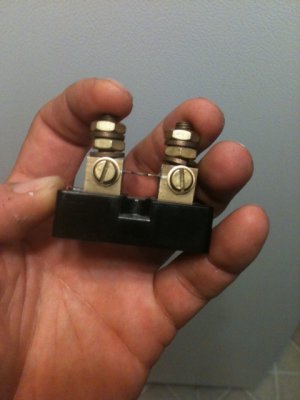Hi....I know that it is possible to connect a combination volt/ammeter in a DC circuit on the negative line using a shunt. The load is a 2 HP DC motor......my question is what can I expect with the volt/ammeter if I change motor turning direction? Thanks.......Casey
-
Welcome back Guest! Did you know you can mentor other members here at H-M? If not, please check out our Relaunch of Hobby Machinist Mentoring Program!
You are using an out of date browser. It may not display this or other websites correctly.
You should upgrade or use an alternative browser.
You should upgrade or use an alternative browser.
Volt / Ammeter in aDC circuit
- Thread starter caseyvand
- Start date
- Joined
- Dec 2, 2012
- Messages
- 1,780
Hi....I know that it is possible to connect a combination volt/ammeter in a DC circuit on the negative line using a shunt. The load is a 2 HP DC motor......my question is what can I expect with the volt/ammeter if I change motor turning direction? Thanks.......Casey
If you are using a digital multi meter, all the ones i have come accross will display a negative sign if you have the leads conected in reverse, but check the manual for your tester.
A 2hp motor will draw quite a lot of current, careful you don't damage the tester with the start up current surge.
Stuart
- Joined
- Nov 16, 2012
- Messages
- 5,596
This is a 100 Amp, 1/2 Ohm linear shunt. You simply place it in series with one of the leads and read the voltage across the terminals. Since V = IR (thus I = V/R) you just read the voltage across the terminals -and since it's 1/2 Ohm, you just double the voltage reading to derive current. These are commonly available in many Amperage ratings and come typically as 1/4, 1/2 or 1 Ohm resistance.
The scant amount of resistance from these things doesn't add-up to beans...
Do not try to put your Ammeter in series with a high power load as few meters can handle that.
Ray

- - - Updated - - -
If you look on eBay for "shunt", you find the modern day equivalent as shown in the link... The one I have is old and is put in/out of service on occasion -but, the last multimeter I purchased has a pretty reliable clamp-type Ammeter that's pretty smart and works on VFD style power.
http://www.ebay.com/itm/DC-4-5-30V-100A-Red-Blue-Led-Dual-Panel-Volt-Amp-Combo-Meter-100A-75mV-Shunt-/261189282593?pt=LH_DefaultDomain_0&hash=item3cd0182b21
Ray

The scant amount of resistance from these things doesn't add-up to beans...
Do not try to put your Ammeter in series with a high power load as few meters can handle that.
Ray

- - - Updated - - -
If you look on eBay for "shunt", you find the modern day equivalent as shown in the link... The one I have is old and is put in/out of service on occasion -but, the last multimeter I purchased has a pretty reliable clamp-type Ammeter that's pretty smart and works on VFD style power.
http://www.ebay.com/itm/DC-4-5-30V-100A-Red-Blue-Led-Dual-Panel-Volt-Amp-Combo-Meter-100A-75mV-Shunt-/261189282593?pt=LH_DefaultDomain_0&hash=item3cd0182b21
Ray

- Joined
- Jan 22, 2011
- Messages
- 8,031
If you're using a DPDT switch to take care of reversing duty, simply place the meter between the power source and the switch instead of between the switch and the motor. No matter which polarity leaves the switch, it will be the same coming in, so the meter will read properly.
- Joined
- Nov 16, 2012
- Messages
- 5,596
Hi.
Any chance you can show a picture or link of the shunt/meter you plan to use? All meters could behave differently. For example, most modern meters should have overload protection that won't burn things out for common hook-up errors. Old meters are much less forgiving of operator error.
Ray
Any chance you can show a picture or link of the shunt/meter you plan to use? All meters could behave differently. For example, most modern meters should have overload protection that won't burn things out for common hook-up errors. Old meters are much less forgiving of operator error.
Ray
Thanks for the input. My idea was to hard wire a (DC +/- 500V / 500A LED volt /amp current combo meter with shunt). If it was hard wired what happens to the readings....would they show as negative....or damage the meter?
- Joined
- Nov 16, 2012
- Messages
- 5,596
That should work fine. The technical notes state it has overload indication -which certainly means it has some form of overload protection. If it gets grossly overloaded it (like most other things) will burn out but, it should be fine for all but extreme abuse.
Ray
Ray
Sorry, but I do not know how to move the information to this form but the Ebay Item number is 190850113608. . Thanks for the help.
Sorry, but I do not know how to move the information to this form but the Ebay Item number is 190850113608. . Thanks for the help.
Yes this will work fine,
If you reverse the the polarity to the motor it will read the same with the exception that it will indicate reverse polarity.
Also you will need to supply 12v dc to make the meter operate.
Thanks to all who contributed to this thread....the information was very helpful. I have ordered a DC 200 volt / 50 amp combination meter. One thing I don't understand is why so many shunts are manufactured with no safety cover to properly insulate the shunt. I did see a few with plastic covers and that's what I'll search for.....Thanks
